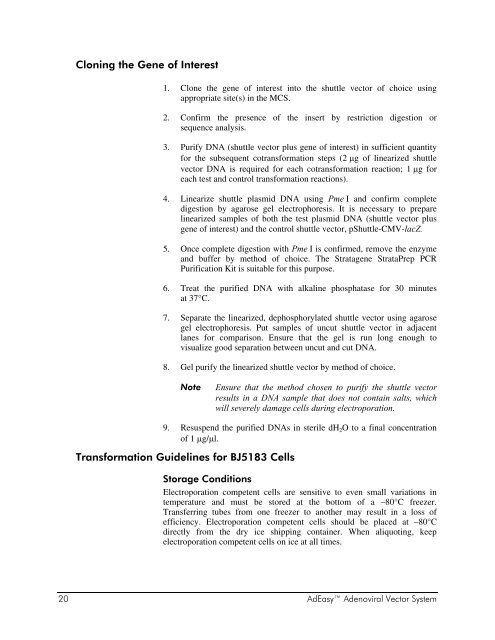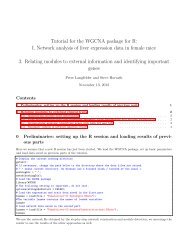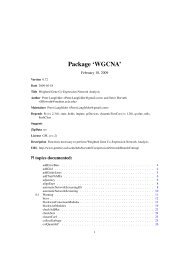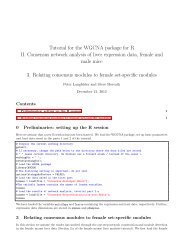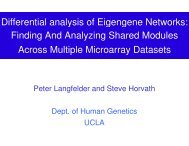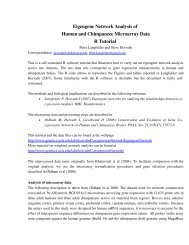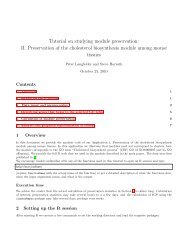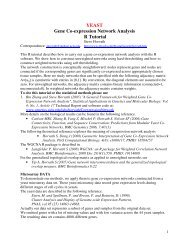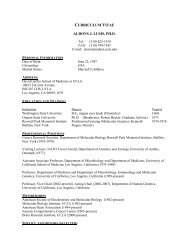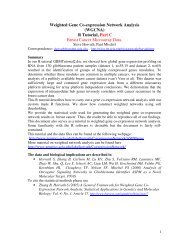Manual: AdEasy Adenoviral Vector System - UCLA Human Genetics
Manual: AdEasy Adenoviral Vector System - UCLA Human Genetics
Manual: AdEasy Adenoviral Vector System - UCLA Human Genetics
Create successful ePaper yourself
Turn your PDF publications into a flip-book with our unique Google optimized e-Paper software.
Cloning the Gene of Interest<br />
1. Clone the gene of interest into the shuttle vector of choice using<br />
appropriate site(s) in the MCS.<br />
2. Confirm the presence of the insert by restriction digestion or<br />
sequence analysis.<br />
3. Purify DNA (shuttle vector plus gene of interest) in sufficient quantity<br />
for the subsequent cotransformation steps (2 μg of linearized shuttle<br />
vector DNA is required for each cotransformation reaction; 1 μg for<br />
each test and control transformation reactions).<br />
4. Linearize shuttle plasmid DNA using Pme I and confirm complete<br />
digestion by agarose gel electrophoresis. It is necessary to prepare<br />
linearized samples of both the test plasmid DNA (shuttle vector plus<br />
gene of interest) and the control shuttle vector, pShuttle-CMV-lacZ.<br />
5. Once complete digestion with Pme I is confirmed, remove the enzyme<br />
and buffer by method of choice. The Stratagene StrataPrep PCR<br />
Purification Kit is suitable for this purpose.<br />
6. Treat the purified DNA with alkaline phosphatase for 30 minutes<br />
at 37°C.<br />
7. Separate the linearized, dephosphorylated shuttle vector using agarose<br />
gel electrophoresis. Put samples of uncut shuttle vector in adjacent<br />
lanes for comparison. Ensure that the gel is run long enough to<br />
visualize good separation between uncut and cut DNA.<br />
8. Gel purify the linearized shuttle vector by method of choice.<br />
Note<br />
Ensure that the method chosen to purify the shuttle vector<br />
results in a DNA sample that does not contain salts, which<br />
will severely damage cells during electroporation.<br />
9. Resuspend the purified DNAs in sterile dH 2 O to a final concentration<br />
of 1 μg/μl.<br />
Transformation Guidelines for BJ5183 Cells<br />
Storage Conditions<br />
Electroporation competent cells are sensitive to even small variations in<br />
temperature and must be stored at the bottom of a –80°C freezer.<br />
Transferring tubes from one freezer to another may result in a loss of<br />
efficiency. Electroporation competent cells should be placed at –80°C<br />
directly from the dry ice shipping container. When aliquoting, keep<br />
electroporation competent cells on ice at all times.<br />
20 <strong>AdEasy</strong> <strong>Adenoviral</strong> <strong>Vector</strong> <strong>System</strong>


